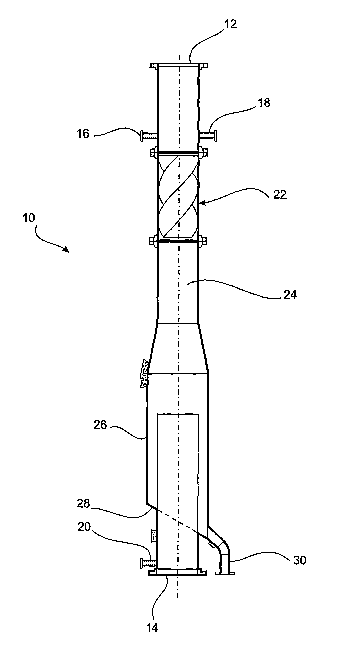Some of the information on this Web page has been provided by external sources. The Government of Canada is not responsible for the accuracy, reliability or currency of the information supplied by external sources. Users wishing to rely upon this information should consult directly with the source of the information. Content provided by external sources is not subject to official languages, privacy and accessibility requirements.
Any discrepancies in the text and image of the Claims and Abstract are due to differing posting times. Text of the Claims and Abstract are posted:
| (12) Patent Application: | (11) CA 2600889 |
|---|---|
| (54) English Title: | SEPARATOR APPARATUS |
| (54) French Title: | APPAREIL DE SEPARATION |
| Status: | Deemed Abandoned and Beyond the Period of Reinstatement - Pending Response to Notice of Disregarded Communication |
| (51) International Patent Classification (IPC): |
|
|---|---|
| (72) Inventors : |
|
| (73) Owners : |
|
| (71) Applicants : |
|
| (74) Agent: | RICHES, MCKENZIE & HERBERT LLP |
| (74) Associate agent: | |
| (45) Issued: | |
| (86) PCT Filing Date: | 2006-02-28 |
| (87) Open to Public Inspection: | 2006-09-08 |
| Availability of licence: | N/A |
| Dedicated to the Public: | N/A |
| (25) Language of filing: | English |
| Patent Cooperation Treaty (PCT): | Yes |
|---|---|
| (86) PCT Filing Number: | PCT/AU2006/000257 |
| (87) International Publication Number: | AU2006000257 |
| (85) National Entry: | 2007-08-30 |
| (30) Application Priority Data: | ||||||
|---|---|---|---|---|---|---|
|
Abstract A separator apparatus (10) characterised by a fluid inlet (12), a
fluid outlet (14), a separated solids outlet (30) and a swirl vane (22), the
swirl vane (22) being located down stream of the fluid inlet (12) but upstream
of the fluid outlet (14) and separated solids outlet (30), the swirl vane (22)
further being arranged so as to impart to the fluid flow passing therethrough
a flow such that entrained particles move radially outward due to inertia, the
fluid outlet (14) being arranged in-line with the fluid inlet (12) and swirl
vane (22) whereas the solids outlet (30) is fed by a radially arranged
collector.
La présente invention concerne un appareil de séparation (10) caractérisé par une entrée de fluide (12), une sortie de fluide (14), une sortie de solides (30) séparée et une vanne tourbillonnante (22), la vanne tourbillonnante (22) étant située en aval de l~entrée de fluide (12) mais en amont de la sortie de fluide (14) et de la sortie de solides (30) séparée, la vanne tourbillonnante (22) étant en outre disposée de façon à transmettre à l~écoulement de fluide la traversant un écoulement tel que les particules entraînées se déplacent radialement vers l~extérieur en raison de l~inertie, la sortie de fluide (14) étant alignée avec l~entrée de fluide (12) et la vanne tourbillonnante (22) tandis que la sortie de solides (30) est alimentée par un collecteur disposé dans le plan radial.
Note: Claims are shown in the official language in which they were submitted.
Note: Descriptions are shown in the official language in which they were submitted.

2024-08-01:As part of the Next Generation Patents (NGP) transition, the Canadian Patents Database (CPD) now contains a more detailed Event History, which replicates the Event Log of our new back-office solution.
Please note that "Inactive:" events refers to events no longer in use in our new back-office solution.
For a clearer understanding of the status of the application/patent presented on this page, the site Disclaimer , as well as the definitions for Patent , Event History , Maintenance Fee and Payment History should be consulted.
| Description | Date |
|---|---|
| Application Not Reinstated by Deadline | 2011-02-28 |
| Time Limit for Reversal Expired | 2011-02-28 |
| Deemed Abandoned - Failure to Respond to Maintenance Fee Notice | 2010-03-01 |
| Amendment Received - Voluntary Amendment | 2008-06-05 |
| Letter Sent | 2008-04-11 |
| Inactive: Single transfer | 2008-01-22 |
| Inactive: Cover page published | 2007-11-20 |
| Inactive: Notice - National entry - No RFE | 2007-11-15 |
| Inactive: First IPC assigned | 2007-10-16 |
| Application Received - PCT | 2007-10-15 |
| National Entry Requirements Determined Compliant | 2007-08-30 |
| Application Published (Open to Public Inspection) | 2006-09-08 |
| Abandonment Date | Reason | Reinstatement Date |
|---|---|---|
| 2010-03-01 |
The last payment was received on 2009-02-12
Note : If the full payment has not been received on or before the date indicated, a further fee may be required which may be one of the following
Patent fees are adjusted on the 1st of January every year. The amounts above are the current amounts if received by December 31 of the current year.
Please refer to the CIPO
Patent Fees
web page to see all current fee amounts.
| Fee Type | Anniversary Year | Due Date | Paid Date |
|---|---|---|---|
| Registration of a document | 2007-08-30 | ||
| Basic national fee - standard | 2007-08-30 | ||
| MF (application, 2nd anniv.) - standard | 02 | 2008-02-28 | 2008-01-10 |
| MF (application, 3rd anniv.) - standard | 03 | 2009-03-02 | 2009-02-12 |
Note: Records showing the ownership history in alphabetical order.
| Current Owners on Record |
|---|
| ALCOA OF AUSTRALIA LIMITED |
| Past Owners on Record |
|---|
| GARY JAMES BROWN |
| KIM GOH |
| PETER STEWART HAY |